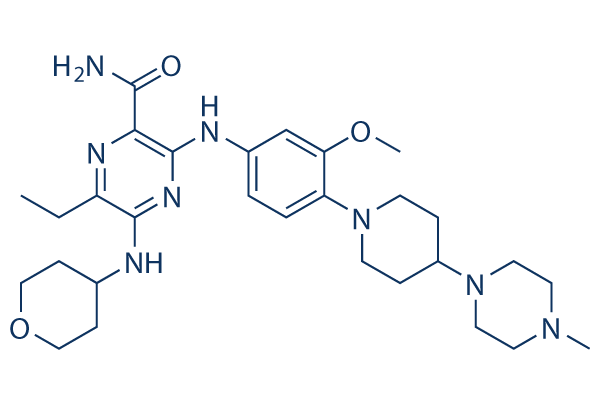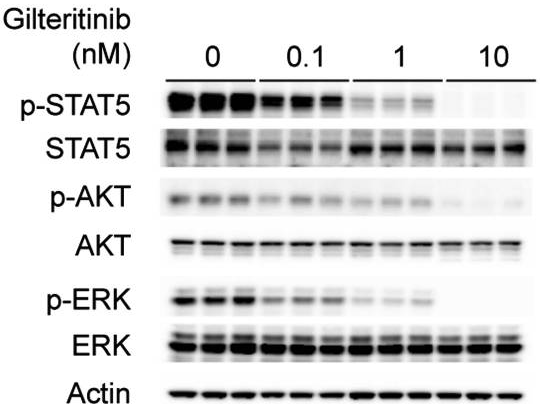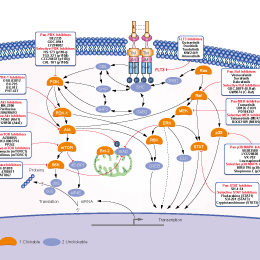
- Bioactive Compounds
- By Signaling Pathways
- PI3K/Akt/mTOR
- Epigenetics
- Methylation
- Immunology & Inflammation
- Protein Tyrosine Kinase
- Angiogenesis
- Apoptosis
- Autophagy
- ER stress & UPR
- JAK/STAT
- MAPK
- Cytoskeletal Signaling
- Cell Cycle
- TGF-beta/Smad
- DNA Damage/DNA Repair
- Compound Libraries
- Popular Compound Libraries
- Customize Library
- Clinical and FDA-approved Related
- Bioactive Compound Libraries
- Inhibitor Related
- Natural Product Related
- Metabolism Related
- Cell Death Related
- By Signaling Pathway
- By Disease
- Anti-infection and Antiviral Related
- Neuronal and Immunology Related
- Fragment and Covalent Related
- FDA-approved Drug Library
- FDA-approved & Passed Phase I Drug Library
- Preclinical/Clinical Compound Library
- Bioactive Compound Library-I
- Bioactive Compound Library-Ⅱ
- Kinase Inhibitor Library
- Express-Pick Library
- Natural Product Library
- Human Endogenous Metabolite Compound Library
- Alkaloid Compound LibraryNew
- Angiogenesis Related compound Library
- Anti-Aging Compound Library
- Anti-alzheimer Disease Compound Library
- Antibiotics compound Library
- Anti-cancer Compound Library
- Anti-cancer Compound Library-Ⅱ
- Anti-cancer Metabolism Compound Library
- Anti-Cardiovascular Disease Compound Library
- Anti-diabetic Compound Library
- Anti-infection Compound Library
- Antioxidant Compound Library
- Anti-parasitic Compound Library
- Antiviral Compound Library
- Apoptosis Compound Library
- Autophagy Compound Library
- Calcium Channel Blocker LibraryNew
- Cambridge Cancer Compound Library
- Carbohydrate Metabolism Compound LibraryNew
- Cell Cycle compound library
- CNS-Penetrant Compound Library
- Covalent Inhibitor Library
- Cytokine Inhibitor LibraryNew
- Cytoskeletal Signaling Pathway Compound Library
- DNA Damage/DNA Repair compound Library
- Drug-like Compound Library
- Endoplasmic Reticulum Stress Compound Library
- Epigenetics Compound Library
- Exosome Secretion Related Compound LibraryNew
- FDA-approved Anticancer Drug LibraryNew
- Ferroptosis Compound Library
- Flavonoid Compound Library
- Fragment Library
- Glutamine Metabolism Compound Library
- Glycolysis Compound Library
- GPCR Compound Library
- Gut Microbial Metabolite Library
- HIF-1 Signaling Pathway Compound Library
- Highly Selective Inhibitor Library
- Histone modification compound library
- HTS Library for Drug Discovery
- Human Hormone Related Compound LibraryNew
- Human Transcription Factor Compound LibraryNew
- Immunology/Inflammation Compound Library
- Inhibitor Library
- Ion Channel Ligand Library
- JAK/STAT compound library
- Lipid Metabolism Compound LibraryNew
- Macrocyclic Compound Library
- MAPK Inhibitor Library
- Medicine Food Homology Compound Library
- Metabolism Compound Library
- Methylation Compound Library
- Mouse Metabolite Compound LibraryNew
- Natural Organic Compound Library
- Neuronal Signaling Compound Library
- NF-κB Signaling Compound Library
- Nucleoside Analogue Library
- Obesity Compound Library
- Oxidative Stress Compound LibraryNew
- Plant Extract Library
- Phenotypic Screening Library
- PI3K/Akt Inhibitor Library
- Protease Inhibitor Library
- Protein-protein Interaction Inhibitor Library
- Pyroptosis Compound Library
- Small Molecule Immuno-Oncology Compound Library
- Mitochondria-Targeted Compound LibraryNew
- Stem Cell Differentiation Compound LibraryNew
- Stem Cell Signaling Compound Library
- Natural Phenol Compound LibraryNew
- Natural Terpenoid Compound LibraryNew
- TGF-beta/Smad compound library
- Traditional Chinese Medicine Library
- Tyrosine Kinase Inhibitor Library
- Ubiquitination Compound Library
-
Cherry Picking
You can personalize your library with chemicals from within Selleck's inventory. Build the right library for your research endeavors by choosing from compounds in all of our available libraries.
Please contact us at info@selleckchem.com to customize your library.
You could select:
- Antibodies
- Bioreagents
- qPCR
- 2x SYBR Green qPCR Master Mix
- 2x SYBR Green qPCR Master Mix(Low ROX)
- 2x SYBR Green qPCR Master Mix(High ROX)
- Protein Assay
- Protein A/G Magnetic Beads for IP
- Anti-Flag magnetic beads
- Anti-Flag Affinity Gel
- Anti-Myc magnetic beads
- Anti-HA magnetic beads
- Poly DYKDDDDK Tag Peptide lyophilized powder
- Protease Inhibitor Cocktail
- Protease Inhibitor Cocktail (EDTA-Free, 100X in DMSO)
- Phosphatase Inhibitor Cocktail (2 Tubes, 100X)
- Cell Biology
- Cell Counting Kit-8 (CCK-8)
- Animal Experiment
- Mouse Direct PCR Kit (For Genotyping)
- New Products
- Contact Us
research use only
Gilteritinib (ASP2215) FLT3 inhibitor
Gilteritinib (ASP2215) is a small-molecule FLT3/AXL inhibitor with IC50 values of 0.29 nM and 0.73 nM for FLT3 and AXL, respectively. This compound inhibits FLT3 at an IC50 value that was approximately 800-fold more potent than the concentration required to inhibit c-KIT (230 nM).

Chemical Structure
Molecular Weight: 552.71
Purity & Quality Control
Batch:
Purity:
99.83%
99.83
Products Often Used Together with Gilteritinib (ASP2215)
It exhibits a stronger proapoptotic effect in hypoxia and coculture with bone marrow stromal cells than Quizartinib.
Compared to this compound, FF-10101 induces significantly more apoptosis of MOLM-14 cells in HS5-conditioned media.
In combination with Fimepinostat, it gives synergistic antileukemic activity against FLT3-internal tandem duplication (ITD) acute myeloid leukemia (AML) cell lines MOLM-13/MV4-11.
Related Products
| Related Targets | FLT3-WT FLT3-ITD FLT3-D835Y | Click to Expand |
|---|---|---|
| Related Products | Dovitinib (TKI-258) Dovitinib (TKI258) Lactate monohydrate Tandutinib (MLN518) KW-2449 ENMD-2076 UNC2025 AST-487 (NVP-AST487) TCS 359 FF-10101 G-749 SKLB4771 (FLT3-IN-1) AMG 925 | Click to Expand |
| Related Compound Libraries | Kinase Inhibitor Library Tyrosine Kinase Inhibitor Library PI3K/Akt Inhibitor Library Cell Cycle compound library Angiogenesis Related compound Library | Click to Expand |
Signaling Pathway
Cell Culture and Working Concentration
| Cell Lines | Assay Type | Concentration | Incubation Time | Formulation | Activity Description | PMID |
|---|---|---|---|---|---|---|
| MV4-11 cells | Cell cycle assay | 1, 3, 10, and 30 nM | 24 h | The mean proportion of MV4-11 cells in G1 phase were significantly increased at gilteritinib concentrations of 3 (69.0%; P<0.01) and 10 nM (70.7%; P<0.001). | 31069015 | |
| MOLM-13 cells | Apoptosis assay | 1, 3, 10, 30, and 100 nM | 48 h | significant increases in the percentage of annexin V-positive cells at concentrations of 30 nM (32.0%) and 100 nM (52.4%) versus control (4.1%) | 31069015 | |
| 32D/TKD cells | Function assay | 50 nM | 6 h | Inhibiton of the phosphorylation of Akt on T308 | 29507660 | |
| TF-1 cells | Function assay | 0, 20, 80, 200 and 500 nM | 1 h | gilteritinib has an IC50 against wild-type c-Kit of 102 nM | 27908881 | |
| BA/F3 | Function assay | Inhibition Assay: A recombinant retrovirus was created from expression plasmid FLAG-EML4-ALKv1/pMX-iresCD8 in which cDNA for EMLA-ALK fusion protein v1 was integrated, and injected into mouse lymphoid cell line BA/F3 cells. Using a magnetic bead reagent f, IC50 = 0.0015 μM. | ChEMBL | |||
| BA/F3 | Function assay | Inhibition Assay: A recombinant retrovirus was created from expression plasmid FLAG-EML4-ALKv1/pMX-iresCD8 in which cDNA for EMLA-ALK fusion protein v1 was integrated, and injected into mouse lymphoid cell line BA/F3 cells. Using a magnetic bead reagent f, IC50 = 0.0015 μM. | ChEMBL | |||
| Vero | Antiviral assay | 24 hr | Antiviral activity against SARS-CoV-2 (viral titer) measured by plaque assay in Vero cells at MOI 0.0125 after 24 hr, IC50 = 6.76 μM. | ChEMBL | ||
| Vero | Cell viability assay | 72 hr | Cell viability measured by CellTiter-Glo assay in Vero cells at MOI 0.05 after 72hr, CC50 = 37.16 μM. | ChEMBL | ||
| Click to View More Cell Line Experimental Data | ||||||
Mechanism of Action
| Targets |
|
|---|
In vitro |
||||
| In vitro | Gilteritinib (ASP2215) demonstrates potent inhibitory activity against the internal tandem duplication (FLT3-ITD) and FLT3-D835Y point mutations in cellular assays using MV4-11 and MOLM-13 cells as well as Ba/F3 cells expressing mutated FLT3. It decreases the phosphorylation levels of FLT3 and its downstream targets in both cellular and animal models. This compound inhibits the activity of eight of the 78 tested kinases by over 50% at concentrations of either 1 nM (FLT3, LTK, ALK, and AXL) or 5 nM (TRKA, ROS, RET, and MER)[1]. Treatment with it for 48h results in an induction of apoptosis in MV4-11 cells as determined by an increase in annexin V-positive cells. It also decreases the expression of anti-apoptotic proteins such as MCL-1, BCL2L10, and survivin, which are reported to be important in chemotherapy sensitivity, following 24h treatment[2]. | |||
|---|---|---|---|---|
| Cell Research | Cell lines | MV4-11 cells | ||
| Concentrations | 0.1 nM, 1 nM, and 10 nM | |||
| Incubation Time | 2 h | |||
| Method | MV4-11 cells are treated with DMSO or increasing concentrations of gilteritinib (ASP2215) for 2 hours, after which immunoprecipitation and immunoblot for phosphorylated FLT3 and total FLT3 are performed. |
|||
| Experimental Result Images | Methods | Biomarkers | Images | PMID |
| Western blot | p-STAT5 / STAT5 / p-AKT / AKT / p-ERK / ERK p-c-kit / c-kit p-FLT3(Y591) / FLT3 |

|
28516360 | |
In Vivo |
||
| In vivo | In vivo, gilteritinib (ASP2215) is distributed at high levels in xenografted tumors after oral administration. The decreased FLT3 activity and high intratumor distribution of this compound translates to tumor regression and improved survival in xenograft and intra-bone marrow transplantation models of FLT3-driven AML. This antitumor activity is associated with a durable inhibition of phospho-FLT3 and phospho-STAT5. Furthermore, treatment with it decreases the leukemic burden and prolongs survival in a mouse IBMT model. No overt toxicity is seen in mouse models treated with gilteritinib[1]. | |
|---|---|---|
| Animal Research | Animal Models | MV4-11 xenografted mice (Nude mice) |
| Dosages | 1 mg/kg, 6 mg/kg, and 10 mg/kg | |
| Administration | oral | |
| NCT Number | Recruitment | Conditions | Sponsor/Collaborators | Start Date | Phases |
|---|---|---|---|---|---|
| NCT06022003 | Recruiting | AML Adult|Refractory AML|Relapsed Adult AML|FLT3-TKD Mutation|FLT3-ITD |
French Innovative Leukemia Organisation|Acute Leukemia French Association |
January 13 2024 | Phase 2 |
| NCT05520567 | Recruiting | Acute Myeloid Leukemia (AML)|FLT3-mutated Acute Myeloid Leukemia |
Astellas Pharma Global Development Inc.|Astellas Pharma Inc |
January 27 2023 | Phase 1|Phase 2 |
| NCT05791890 | Active not recruiting | Acute Myeloid Leukemia |
University of Rome Tor Vergata |
May 31 2022 | -- |
References |
|
Chemical Information
| Molecular Weight | 552.71 | Formula | C29H44N8O3 |
| CAS No. | 1254053-43-4 | SDF | Download SDF |
| Synonyms | N/A | ||
| Smiles | CCC1=C(N=C(C(=N1)C(=O)N)NC2=CC(=C(C=C2)N3CCC(CC3)N4CCN(CC4)C)OC)NC5CCOCC5 | ||
Storage and Stability
| Storage (From the date of receipt) | |||
|
In vitro |
DMSO : 4 mg/mL ( (7.23 mM) Moisture-absorbing DMSO reduces solubility. Please use fresh DMSO.) Water : Insoluble Ethanol : Insoluble |
Molecular Weight Calculator |
|
In vivo Add solvents to the product individually and in order. |
In vivo Formulation Calculator |
|||||
Preparing Stock Solutions
Molarity Calculator
In vivo Formulation Calculator (Clear solution)
Step 1: Enter information below (Recommended: An additional animal making an allowance for loss during the experiment)
mg/kg
g
μL
Step 2: Enter the in vivo formulation (This is only the calculator, not formulation. Please contact us first if there is no in vivo formulation at the solubility Section.)
% DMSO
%
% Tween 80
% ddH2O
%DMSO
%
Calculation results:
Working concentration: mg/ml;
Method for preparing DMSO master liquid: mg drug pre-dissolved in μL DMSO ( Master liquid concentration mg/mL, Please contact us first if the concentration exceeds the DMSO solubility of the batch of drug. )
Method for preparing in vivo formulation: Take μL DMSO master liquid, next addμL PEG300, mix and clarify, next addμL Tween 80, mix and clarify, next add μL ddH2O, mix and clarify.
Method for preparing in vivo formulation: Take μL DMSO master liquid, next add μL Corn oil, mix and clarify.
Note: 1. Please make sure the liquid is clear before adding the next solvent.
2. Be sure to add the solvent(s) in order. You must ensure that the solution obtained, in the previous addition, is a clear solution before proceeding to add the next solvent. Physical methods such
as vortex, ultrasound or hot water bath can be used to aid dissolving.
Tech Support
Answers to questions you may have can be found in the inhibitor handling instructions. Topics include how to prepare stock solutions, how to store inhibitors, and issues that need special attention for cell-based assays and animal experiments.
Tel: +1-832-582-8158 Ext:3
If you have any other enquiries, please leave a message.
* Indicates a Required Field






































